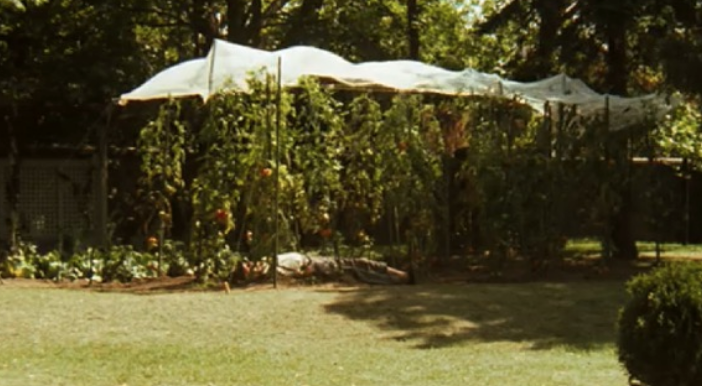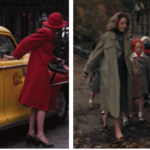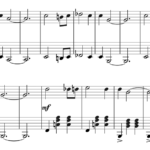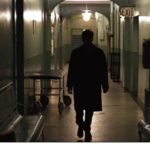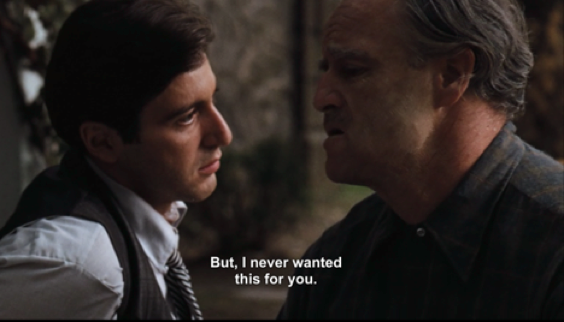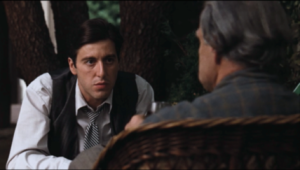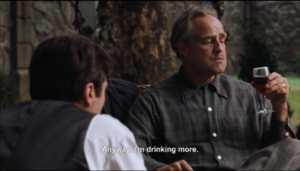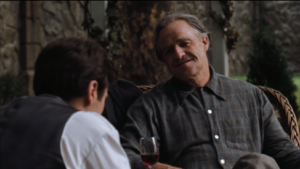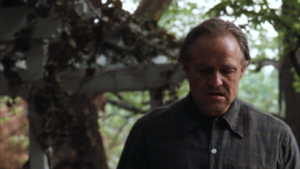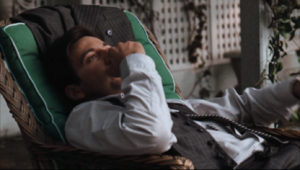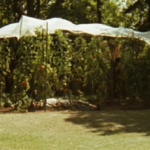Ripeness Is All: The Death of Vito Corleone
By Daniel Arias
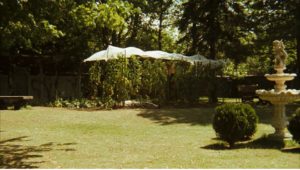 Late in The Godfather, when Vito Corleone collapses to the ground and his grandson Anthony runs away to get help, viewers are left to look at the former Don’s body lying motionless in the shade of a trellised tomato garden. For five seconds, the only sounds that fill the soundtrack are the birds chirping and the wind blowing through the trees; then the image fades and funeral bells ring in the next scene. Unlike other critical scenes in the film, which rely on dramatic sequence and action, or intriguing dialogue between characters, this scene has a different way of registering with the viewer: its significance is encapsulated in the symbolic images that frame Vito’s final moments and the non-verbal gestures shared between Vito and his grandson.
Late in The Godfather, when Vito Corleone collapses to the ground and his grandson Anthony runs away to get help, viewers are left to look at the former Don’s body lying motionless in the shade of a trellised tomato garden. For five seconds, the only sounds that fill the soundtrack are the birds chirping and the wind blowing through the trees; then the image fades and funeral bells ring in the next scene. Unlike other critical scenes in the film, which rely on dramatic sequence and action, or intriguing dialogue between characters, this scene has a different way of registering with the viewer: its significance is encapsulated in the symbolic images that frame Vito’s final moments and the non-verbal gestures shared between Vito and his grandson.
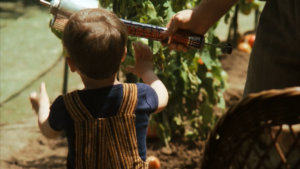 It is no accident that the central prop of this scene is a watering gun — an implement which evokes power and the potential for violence but does so lightly, even ironically. (Water, not bullets, issue from its ‘barrel’.) Just before this scene, Vito speaks to his son, Michael, in the same garden. In that scene, Vito grapples with the guilt and uncertainty of having to transfer his power down to the next generation. Handing his status and the family business to Michael, he wants also to advise his son and ensure that the business can flourish. Though Michael is not unkind with Vito, neither is he overly deferential: the scene signals clearly that Michael, as the new Don, will make his own decisions.
It is no accident that the central prop of this scene is a watering gun — an implement which evokes power and the potential for violence but does so lightly, even ironically. (Water, not bullets, issue from its ‘barrel’.) Just before this scene, Vito speaks to his son, Michael, in the same garden. In that scene, Vito grapples with the guilt and uncertainty of having to transfer his power down to the next generation. Handing his status and the family business to Michael, he wants also to advise his son and ensure that the business can flourish. Though Michael is not unkind with Vito, neither is he overly deferential: the scene signals clearly that Michael, as the new Don, will make his own decisions.
This power dynamic is reenacted in the garden scene when Vito hands his grandson the watering gun. As a fatigued old grandfather, Vito can no longer stand for too long and he must sit down to watch Anthony play. From this position, Vito still seeks out any control he might have, shouting at his grandson, “over her, over here. Be careful, you’re spilling it, you’re spilling it. Anthony, come here, come here. Come here.” In the same way that he cannot control how Michael runs the family business, Vito cannot control how Anthony uses the water gun to feed the tomato vines. He has passed down the power to the new generation of his family: how they use that power, and how it affects them, are completely out of his control.
***
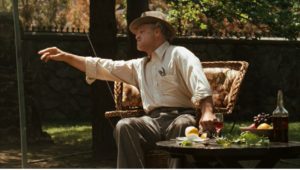 Vito Corleone’s loss of power is reflected in his physical appearance and presentation. In the introductory scene of the film, Vito comes across as a powerful figure. His words carry weight and deliberation in his monologue; he wears a fine suit, and his hair neatly slicked back. By contrast, this scene presents Vito in casual clothing, and with unruly hair protruding out of his hat. His body appears languid and shriveled by age. It is a portrait of a powerless Don. Even the simple act of calling out to his grandson and extending his arm as gesture seems like an extra strain on his body.
Vito Corleone’s loss of power is reflected in his physical appearance and presentation. In the introductory scene of the film, Vito comes across as a powerful figure. His words carry weight and deliberation in his monologue; he wears a fine suit, and his hair neatly slicked back. By contrast, this scene presents Vito in casual clothing, and with unruly hair protruding out of his hat. His body appears languid and shriveled by age. It is a portrait of a powerless Don. Even the simple act of calling out to his grandson and extending his arm as gesture seems like an extra strain on his body.
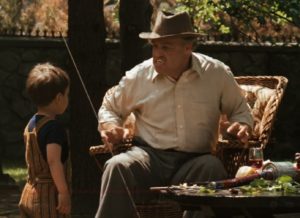 The only gesture of power that Vito conveys in this scene is reliant on artifice. To get his grandson’s attention, Vito cuts an orange peel and fashions a pair of fangs for his mouth. In his final exertion of power before he dies, he pretends to be a big and scary monster to frighten his grandson. The performance of power is what leads to his death — both literally, in this scene, and symbolically for the overall story arc of his character. Through much of the film, Vito has performed the role of mafia Don as the ultimate exertion of his power, but in this scene, viewers are offered a glimpse into what Vito Corleone looks like without his presentation and appearance as the powerful Don Corleone. When he adorns himself with a pair of fangs, to play pretend with his grandson, the scene frames the gesture as a representation of how Vito performs throughout the film; the only difference here is that viewers witness the process of how Vito transforms himself to convey power, even if it is just to frighten his grandson for a brief moment.
The only gesture of power that Vito conveys in this scene is reliant on artifice. To get his grandson’s attention, Vito cuts an orange peel and fashions a pair of fangs for his mouth. In his final exertion of power before he dies, he pretends to be a big and scary monster to frighten his grandson. The performance of power is what leads to his death — both literally, in this scene, and symbolically for the overall story arc of his character. Through much of the film, Vito has performed the role of mafia Don as the ultimate exertion of his power, but in this scene, viewers are offered a glimpse into what Vito Corleone looks like without his presentation and appearance as the powerful Don Corleone. When he adorns himself with a pair of fangs, to play pretend with his grandson, the scene frames the gesture as a representation of how Vito performs throughout the film; the only difference here is that viewers witness the process of how Vito transforms himself to convey power, even if it is just to frighten his grandson for a brief moment.
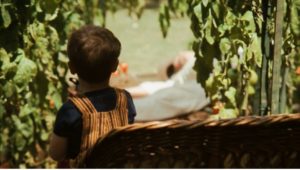 Chasing his grandson through the tomato vines, Vito removes his orange peel fangs —and tellingly, it is at this moment that he erupts into the coughing fit that results in his collapse. Playing pretend with his grandson has been too much of a physical strain on his body; Vito gives up his monster act, and gives up the ghost. Likewise, Vito’s performance of power as Don has been the ultimate exertion in his life. He has structured his whole life and family around the power and persona of Don Corleone, and the toll ends up being too much to handle: Vito crumbles and falls in the tomato garden. He lies on the ground, next to the ripe, or possibly overripe, tomatoes that have burdened the vine branch with their own weight and have fallen to litter the soil.
Chasing his grandson through the tomato vines, Vito removes his orange peel fangs —and tellingly, it is at this moment that he erupts into the coughing fit that results in his collapse. Playing pretend with his grandson has been too much of a physical strain on his body; Vito gives up his monster act, and gives up the ghost. Likewise, Vito’s performance of power as Don has been the ultimate exertion in his life. He has structured his whole life and family around the power and persona of Don Corleone, and the toll ends up being too much to handle: Vito crumbles and falls in the tomato garden. He lies on the ground, next to the ripe, or possibly overripe, tomatoes that have burdened the vine branch with their own weight and have fallen to litter the soil.
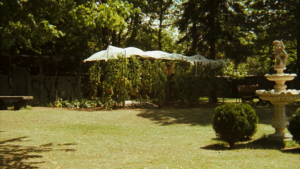 At the very moment of Vito’s death, Coppola notably cuts to a more distant shot. The camera frames the tomato garden at the center of the backyard; in the confines of the garden lies Vito’s body. The image of Vito resting on the soil, the foundation of the garden, resonates with Vito’s role as the foundation of his family and business. He has worked and exerted himself completely to maintain the growth of his personal and family legacy. As a result, like the ripe tomatoes that must fall to make room for new ones, Vito must fall in order to make room for the new Don, his son.
At the very moment of Vito’s death, Coppola notably cuts to a more distant shot. The camera frames the tomato garden at the center of the backyard; in the confines of the garden lies Vito’s body. The image of Vito resting on the soil, the foundation of the garden, resonates with Vito’s role as the foundation of his family and business. He has worked and exerted himself completely to maintain the growth of his personal and family legacy. As a result, like the ripe tomatoes that must fall to make room for new ones, Vito must fall in order to make room for the new Don, his son.
There’s a sense that, even as this scene portrays the death of Vito Corleone, it also encapsulates his life. Vito has done everything in his power to plant, care for, and grow the seeds of his personal and business life. By laying the foundation for his generation and the generations to come after him, he has become the foundation. Coppola gives us as viewers five seconds to hear the wind and the birds chirping so that we register that this is a natural death — one that, for all its sadness, completes a cycle.

